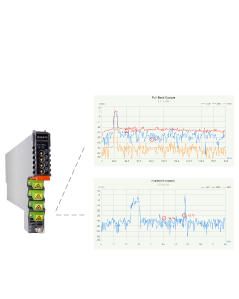AIMA-RRAR
Analog Return Receiver - Redundant
* For RRAR-Q-M, please download the firmware of RRAR and
the one of RRAR FBC module.
* Login required for all downloads

About the Product
The PBN AIMA3000 RRAR series Analog Return Receiver - Redundant (RRAR) are designed for multi-services operators to increase networkreturn capacities for the ever-growing demand for data and voice bandwidth, while minimizing physical headend space and power requirements.
The RRAR, is designed to plug into PBN’s latest generation Advanced Intelligent Multi- Service Headend Platform (AIMA3000). The RRAR incorporates four independent optical return-path receivers that can operate at any wavelength between 1260~1620 nm. This density allows up to 64 independent receivers in only 4 RU of space. The user can set each receiver individually for operation in either manual gain control (MGC) mode or automatic gain control (AGC) mode based on optical input power. The unit has a low-noise profile and highperformance amplifiers to ensure a good signal-to-noise ratio as well as low distortion characteristics. With high RF outputs, the RRAR can be adapted to work with various headend configurations.
The RRAR can be used independently as a 4-port return receiver, or it can be matched with another RRAR to provide line and equipment redundant protection for the uplink channel. The two RRARs that are backup to each other are connected by a redundant cable. The user can designate a port of one equipment and any port of the other equipment as a group of primary and secondary outputs. After the setting is completed, under normal circumstances, the primary port has output level, and the secondary port has no output level. When an abnormal situation occurs in the primary port (module power failure/optical input power exceeding limit), the primary output will be closed and the secondary output will be opened, so as to realize redundant protection.
With the optional embedded Full Band Capture (FBC) module, it enables the operator to capture and monitor the return path spectrum helping the operator to quickly find and locate the upstream noise and the related upstream signal levels. Advanced spectrum analyzing software is available as in a standalone version or as module within PBN’s NMSE Software suite. It also can be easily integrated into operators exist network management system.
The RRAR can also be conveniently monitored and controlled through a computer connected to one of the Ethernet ports via the ASMM module.
All module settings are retained in non-volatile memory to ensure trouble-free operation. Bulk updating, automatic uploading and downloading of configuration files is possible using PBN’s NMSE web-based management system.
|
|
|
Optical Performance |
|
| Optical wavelength | 1260 nm to 1620 nm |
| Optical inputs | -18 dBm to +2 dBm |
| Optical return loss | > 50 dB |
| Optical connectors | 4 x SC/APC (1) , FC/APC, LC/APC, E2000/APC |
|
RF Performance |
|
| RF bandwidth | 5 MHz to 204 MHz |
| RF output level(2) | 47.5 dBmv @ -6 dBm |
| RF flatness | ± 0.75 dB (5 MHz to 204 MHz) |
| Gain adjustment | up to 45 dB in 0.5 dB increments (default 35 dB) |
| RF impedance | 75 Ω |
| RF return loss | > 18 dB |
| Receiver isolation | > 65 dB |
| RF test point relative to RF output port |
-20 dB ± 1 dB |
| RF connectors | 4 x GSK-type female |
| RF test points | 4 x Mini-SMB |
| Alarms and status | Front-panel LEDs, SNMP Traps |
| Redundant switching time | < 50 ms |
| Equivalent input noise | < 4.5pAHz |
|
Link Performance |
||
| CNR (3) | > 51 dB | |
| IMD2 (3) | > 61 dB | |
| NPR (4) | ≥ 25 dB (Dynamic range @ 30 dB) | |
|
General |
|
| Power supply | Powered via AIMA3000 backplane |
|
Power consumption |
< 18 W (without FBC) < 24 W (with FBC) |
| Operating temperature | -5 ℃ to +55 ℃ |
| Storage temperature | -25 ℃ to +70 ℃ |
| Operating humidity | 90% (non-condensing) |
| Storage humidity | 90% (non-condensing) |
| Dimensions (WxDxH) | 24.6 x 410 x 152.5 mm |
| Weight | 0.87 kg |
| Supported network management options |
PBN's NMSE or through ASMM's Web Interface |
|
With the FBC module |
|
| Frequency Capture Range | 5 to 204 MHz |
| Dynamic range | 60 dB |
| Spectrum Lines | 3, including live, max hold and min hold |
| RBW | Up from 30 KHz |
| VBW | Auto adaptable |
| Vertical Markers | 2 |
Notes:
(1) Standard option. Contact a PBN Sales Representative for availability of other options.
(2) Measured in a typical system with -6 dBm optical input, 6% OMI, gain setting adjusted to typical (the stated RF output level does not necessarily apply with other optical input levels). dBuV= 60+dBmV.
(3) Measured in a typical system with PBN Standard Return Transmitter, 4 channels (11.5 MHz, 26.5 MHz, 45.5 MHz and 58.5 MHz), -6 dBm, 7% OMI, Output level 44 dBmV per Channel.
(4) Measured in a typical system with PBN Standard Return Transmitter, -13 dBm optical input, 35 MHz noise loading.
| A-RRAR-[W]-[X]-[Y]-[Z] | Analog Return Receiver - Redundant | |
|
Options: |
||
|
W |
Optical Ports |
|
|
Q |
Quad (4) |
|
|
X |
FBC Function(1) |
|
|
M |
With FBC Management (1) |
|
|
Y |
Optical Connector Type |
|
|
S E F L |
SC/APC E2000/APC FC/APC LC/APC |
|
|
Z |
Bandwidth |
|
|
20 |
5 ~ 204 MHz (Standard) | |
Note:
(1) Option for FBC Management configurations only, if not used omit X when making an order.



